
A Visit to Old Los
Angeles
3. Main Street
(Part 1).
by
Brent C. Dickerson
Copyright © Brent C. Dickerson
Index to Episodes (click here)
Main Street, south to Fourth.
• Our travelers would have been familiar with the look of towns of the old West, from their experiences back home on the prairies. Los Angeles had experienced several booms of development since that era!—and much of the old construction had been swept away. But we do well to remember that Los Angeles was indeed once a frontier town of the Wild West. Here is an 1857 view up Main Street from somebody's roof just north of 1st Street towards the old Plaza we visited. The side of the tower of the church we saw in the Plaza can be made out, barely, at the far end of the street. Closer, the two-story building at the left, with overhang and posts, is the Temple Block, built by Don Juan Temple, across from Temple's General Store (note the latter's angled rather than square corner; this reflects the fact that this is the point at which old Spring Street angled into Main Street). We will see the Temple Block in two guises very shortly. Remember in our visit to the Plaza area we saw the Pico House and the Baker Block? Pico House would be built at the far end of the line of buildings which stretch from the immediate foreground into the picture nearly to the church, with the site of the Baker Block a little closer.

• And so, with the Baker Block about a block or so behind us, we take up again our walk south on Main Street. In this view excerpted from another card, we look south along the west face of Main Street between Temple Street and First Street—that is, the west side of the 100 north block of Main. That we are in the area of the nucleus of the old city is betokened by the fact that the brick building facing us is the new Temple Block, across from the old Temple block, both of them built by the man for whom the cross-street, Temple, was named—Jonathan (or John) Temple, called Don Juan Temple by old Angelenos; Temple had come to Los Angeles in 1827, at length opened the city's first General Store, and died in 1866.
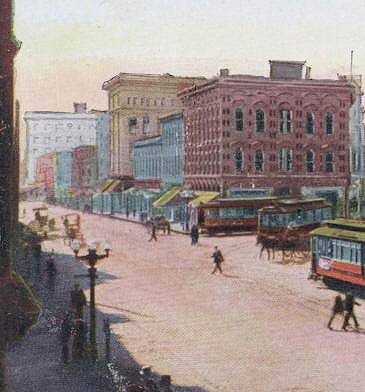
• And here is the Temple Block in the state that Mr. Temple would have known, which we saw a moment ago, from the side, from farther down the street. The picture is from 1857, and is from very nearly the same angle as the more modern view above, though slightly closer. Note the "signboard" at front top of the building; this signboard motif was retained for the more modern building, no doubt as an affectionate remembrance of the appearance of Temple's old familiar building.
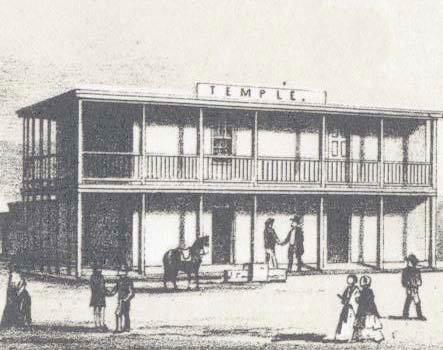
• 1st Street is the next street south. At the southwest corner of Main and 1st is the Natick House hotel.
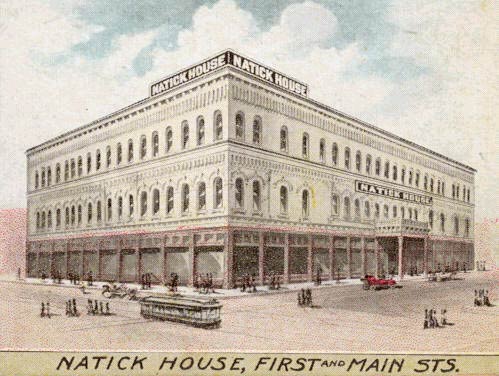
• Looking west on First Street from Main to its corners with Spring, Broadway, and Hill. Dear, I felt as if I were in New York City or Chicago with all the business and bustle!
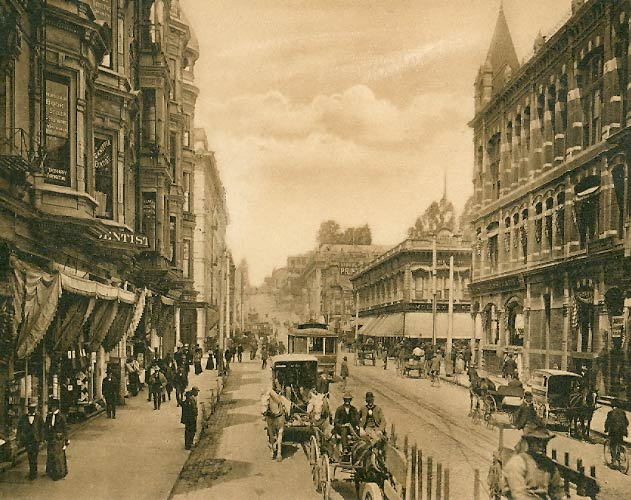
• We turn to look south down Main from its intersection with 1st Street. The Natick House is to the right in this view. Childs' Opera House is the building with the flag on the left. The T.D. Mott Building, which hosted the Chamber of Commerce from 1890-1894, is the building very nearly at dead center with arched windows on the second floor facing the street. Thomas Dillingham Mott arrived in Los Angeles in 1852, was a stable-keeper by 1860, married Maria Ascencion Sepulveda in 1861, was County Clerk 1863-1869, and became political boss of the Democratic Party in L.A. County. In 1871, he became a State Assemblyman.
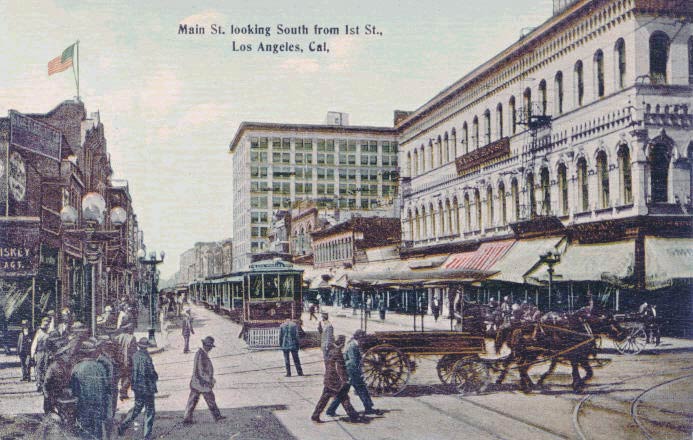
• We walk another block south, and
find the Higgins Building at the southwest corner of Main and
Second.
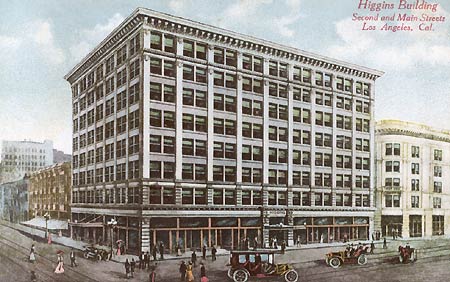
• Practically across the street is gracious old St. Vibiana's Cathedral, dating back to the 1870s, on the east side of the 200 block of south Main St.
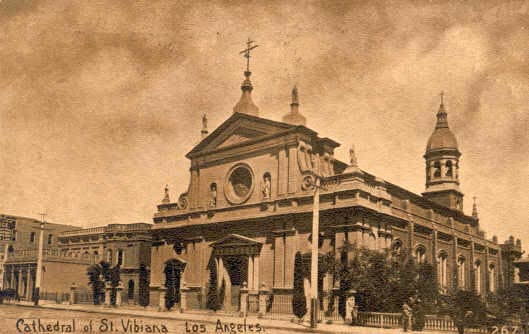
• St. Vibiana's in the context of its surroundings, from about 1885, when the trolleys were still horse-drawn. We look north on Main Street.
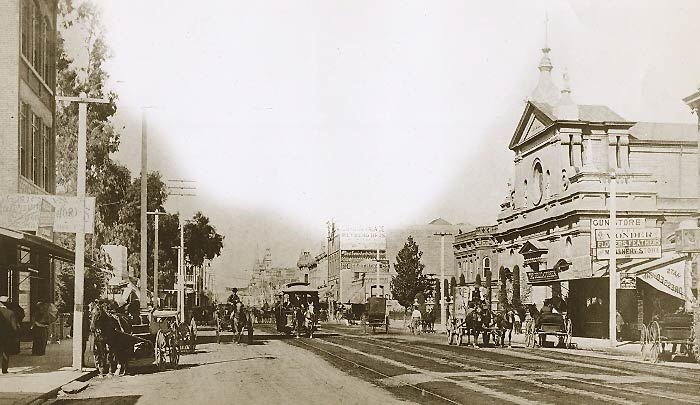
• I looked across the street from the cathedral's Main Street door, and announced, "Churches are all very well..."—Mother darted me a look of caution—"...but the only way I feel hole-y at the moment pertains to my stomach. Do I see me a cafe, fellow wanderers on the bleak surface of the earth?" "Oh, yes, Ulf—Levy's Cafe," cried Minnie; "a piece of apple pie would address my holiness, I must confess!" "Walk on, my starvelings, walk on," said Mother, "we will have food enough later." Levy's Cafe, a posh eatery of the era, was in the building at center with the arched windows in the upper story. We see the Higgins Building in the distance at the corner with Second Street.
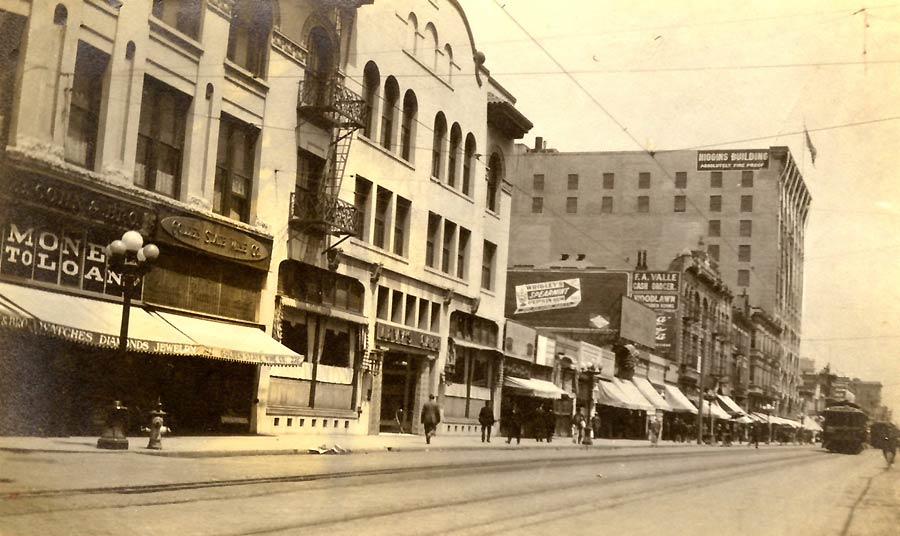
• Minnie stuck her head in the door of Levy's Cafe, and whispered to me, "Well, we wouldn't have needed a reservation!"
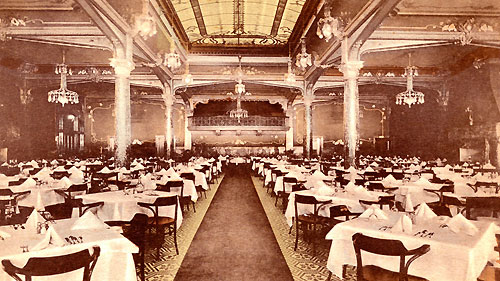
• From St. Vibiana's, we look south to Main Street's corner with Third St.
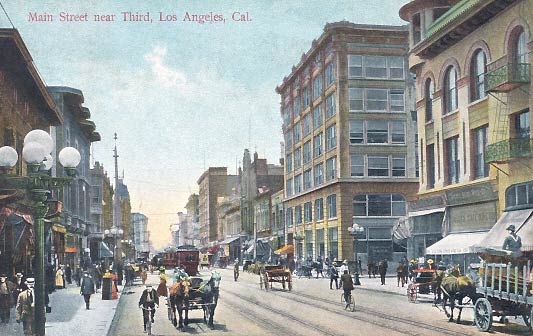
• The brightly-lit Liberty Theater—and with "continuous performances" to boot!—is at our left, just before the corner with the eastern portion of Third Street; as we shall see, it looks up the western portion of Third.

• We look down on Main Street from a point several blocks west on Third Street. Despite all appearances, Third Street does not dead-end at Main, but begins again a few yards to the south. The low building on Main with a facade consisting primarily of one great arch is the Liberty Theater.

• Now we reverse, and look west on Third Street from Main Street. The family will return here later for a walk across town on Third Street. The eastward section of Third does not start directly across from the westward section, but rather a few yards south on Main.

• Young Frederick Johan has learned from Papa to be very circumspect, and looks back north on Main just after we have passed Third Street. The building which dominates on the right is the Hotel Gray, at the northeast corner of Main and Third.

• And a few steps down the block, at 319 S. Main Street, we find the "New Turner Hall Cafe," the name recognizing the fact that it was on the site of the old "Hallen-Gebäude des Turnverein Germania," an early club focusing on German traditions and physical culture.
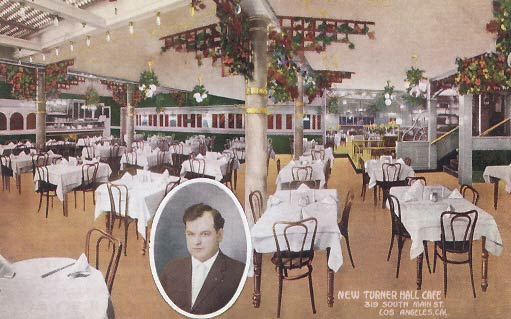
| • The Canton Cafe was next door at 321 S. Main Street (it later moved to address 527). Note the player-piano roll boxes on top of the piano. | 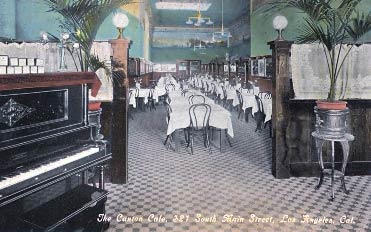 |
• It wasn't more than a step or two further before we came to the Belasco Theater, which looked neat and new. "There's no shortage of theaters in this town," quoth I; "this'll be the third we've passed on this street alone." Anna looked in and bit her lip. "I've never understood the attraction of sitting in the dark watching people do unnatural things," she said. "Well, my girl," said Papa, "I should think—I really do—that it's better that way than being out in the open doing them yourself."

• The Westminster Hotel loomed proudly over us across the street, ending at the northeast corner of Main and Fourth. You can see a bit of it reflected in the windows of the Belasco. Note the hotel's tower, a minor landmark frequently peeking out in city views. Off to the right, we see just a bit east down Fourth Street towards Los Angeles Street.
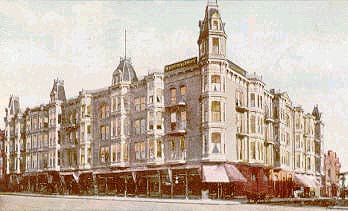
• The closer we came to it, the more imposing and castle-like the hotel seemed. But Minnie broke the spell. "I see," said she, looking archly at Charley, "that one can have one's hair cut here..." "I see," responded Charley, looking equally archly at Minnie, "that one can get a bath here..." "I tink," said Papa, squinting at the prices of some souvenirs in a shop window, "dat one can get shorn by most sellers here, ja, and get taken for a bath, too."

• As we crossed the street and passed along in front of the hotel, I had a notion to look into the lobby, as it seemed like a fine old place. Just as I pulled open the door—it was heavy with leaded glass—a man brushed by me, going out, muttering "We'll meet again...," and I anticipated seeing whomever he was talking to on the other side of the door. No! The lobby was empty.

• "Do you know that man?", enquired Minnie, jerking her thumb in the direction of the man going out. "What do you mean? I hardly even noticed him," I said. She looked at me, blinking once or twice. "Well, he was talking to you!". I started to turn back to look down the street for him; but suddenly Minnie grabbed me by the shoulder. "Look—we can eat here!" she shouted in my ear, pulling me off towards a door marked "Café". Charley, who was next behind us, cleared his throat and said, "Minnie, must you always beat about the bush? Just what is it that you want?". As the two of them were bickering, I pushed open the door and young Frederick Johan and I looked inside to another empty room. Quoth young FJ, "They're not open yet, Minnie. But look at the placard—just like you, they're 'Of Established Reputation and So Left Standing.'" As Minnie gave him a wry look, Mother broke in with, "Young man, mind your tongue or you'll be 'standing' because your bottom will be too sore to sit."
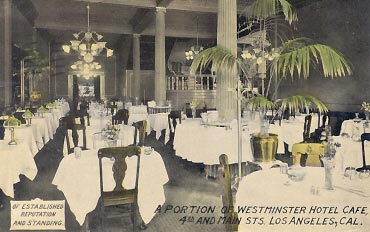
• There's an interesting building at every corner of Main and Fourth! At the southeast corner, we see the very solid San Fernando Building. In this view, Main Street extends southward in the right-hand portion, while Fourth Street goes towards the rising sun off to the left. At the extreme right of the view, we see just a piece of the Farmer's and Merchant's Bank.

• Main Street near Fourth Street, looking north (left; the prominent building on the right half of the card is the Westminster Hotel again; and we again see a piece of the Farmer's and Merchant's Bank, this time at the extreme left); and Main Street from the middle of the 300s block, looking south (right-hand card), the Westminster Hotel (with shops at the ground level) being on the left of the card—while the F&M Bank this time can be seen as the low white building in the middle on the right.
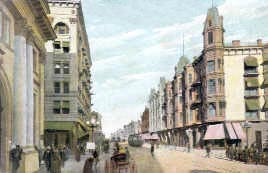 |  |
• The Van Nuys Hotel, Main Street going north to the right, Fourth Street going west out of the picture at left. Immediately to the right of the hotel, we see a lone remnant of the area's residential past, the upper half at least of a cozy little house, doubtless converted to commercial use by this stage of the street's urbanization.

• Looking west on Fourth St. at Main: On the northwest corner, the Van Nuys Hotel (later the Barclay), built in 1896; as we could all hear Minnie's stomach growling, we stopped for a snack in its café.
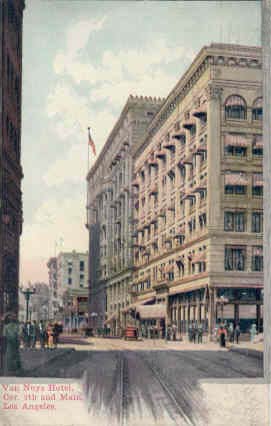 | 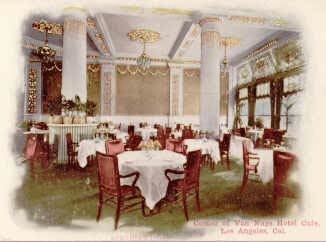 |
• On the southwest corner, a very classical look! Yes, it's the Farmer's and Merchant's Bank again—finally, a good view of it. The tallest building, on the right in our view and a block away at Spring and Fourth, is the Hibernian Bldg., also called the Union Trust or Braly Bldg. (and now called the Continental Bldg.), always a prominent landmark in downtown; we see its unornamented back face from our position (in the tower of the Westminster Hotel) at Main and Fourth. Meantime, off to the left back on Main, towards the other end of the block not quite to Fifth Street, we can see the older incarnation of the Rosslyn Hotel, very familiar today in its newer incarnation on the next lot south, right at Fifth Street.

• Every street in downtown Los Angeles has its own character, its own feel, as we came to realize. Main, Spring, Broadway, Hill—stand at each one's corner with Fourth Street, look north, and one feels a different ambience. "As for me," said Anna, evidently reading my thoughts, or over my shoulder as I write this, "I say, 'Be it ever so humble, there's no place like home!'" Mother gave her a sharp look, and said, "Our home is not humble. Our home is grand. Our pride is humble." "So to speak," added Charley. "As for me," quoth Papa, "I say, 'Cross the street and don't get run over by a trolley!'"
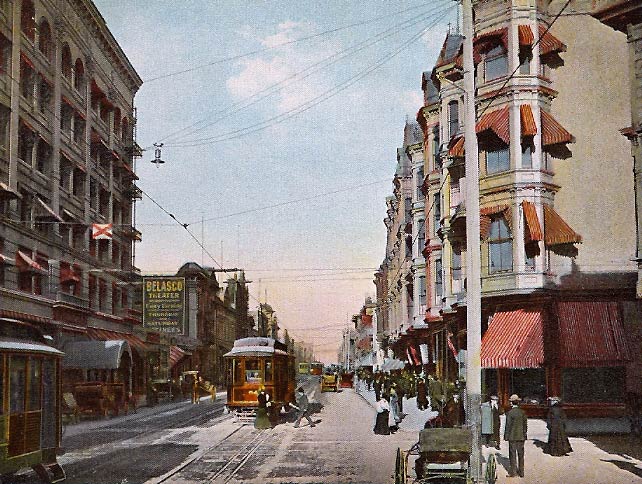
Go back to East of Main Street. or Go on to Main Street Part 2.